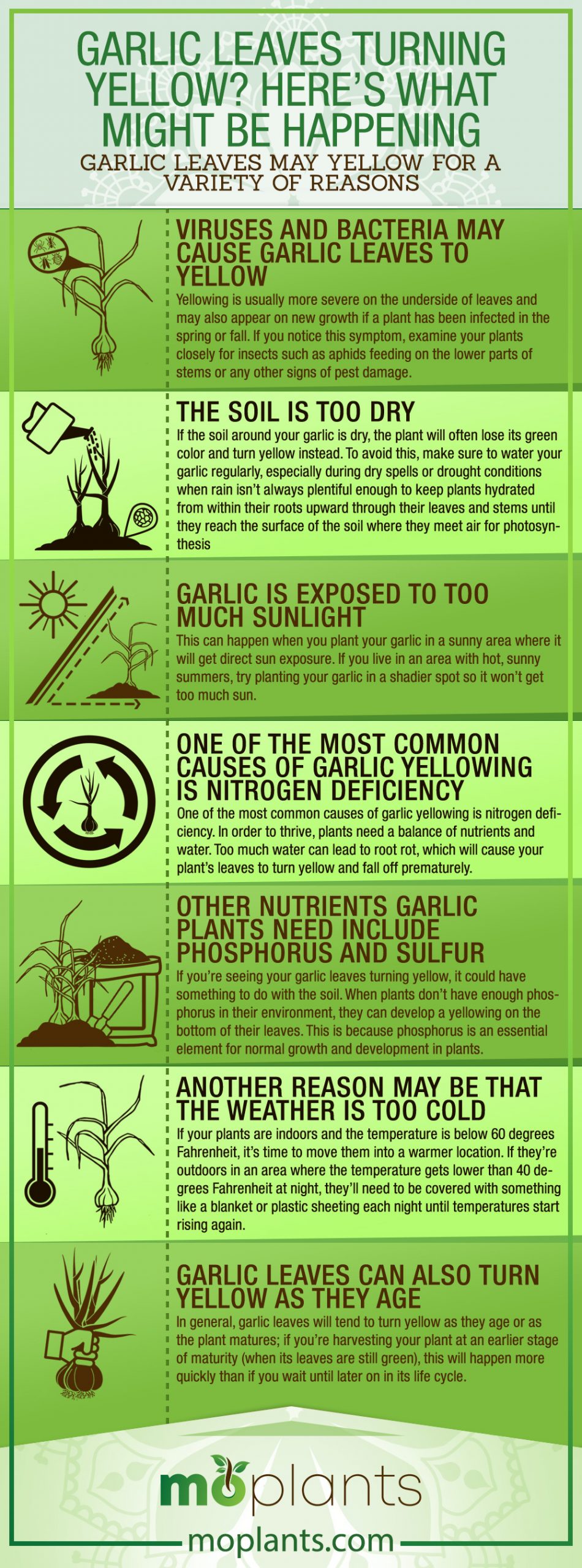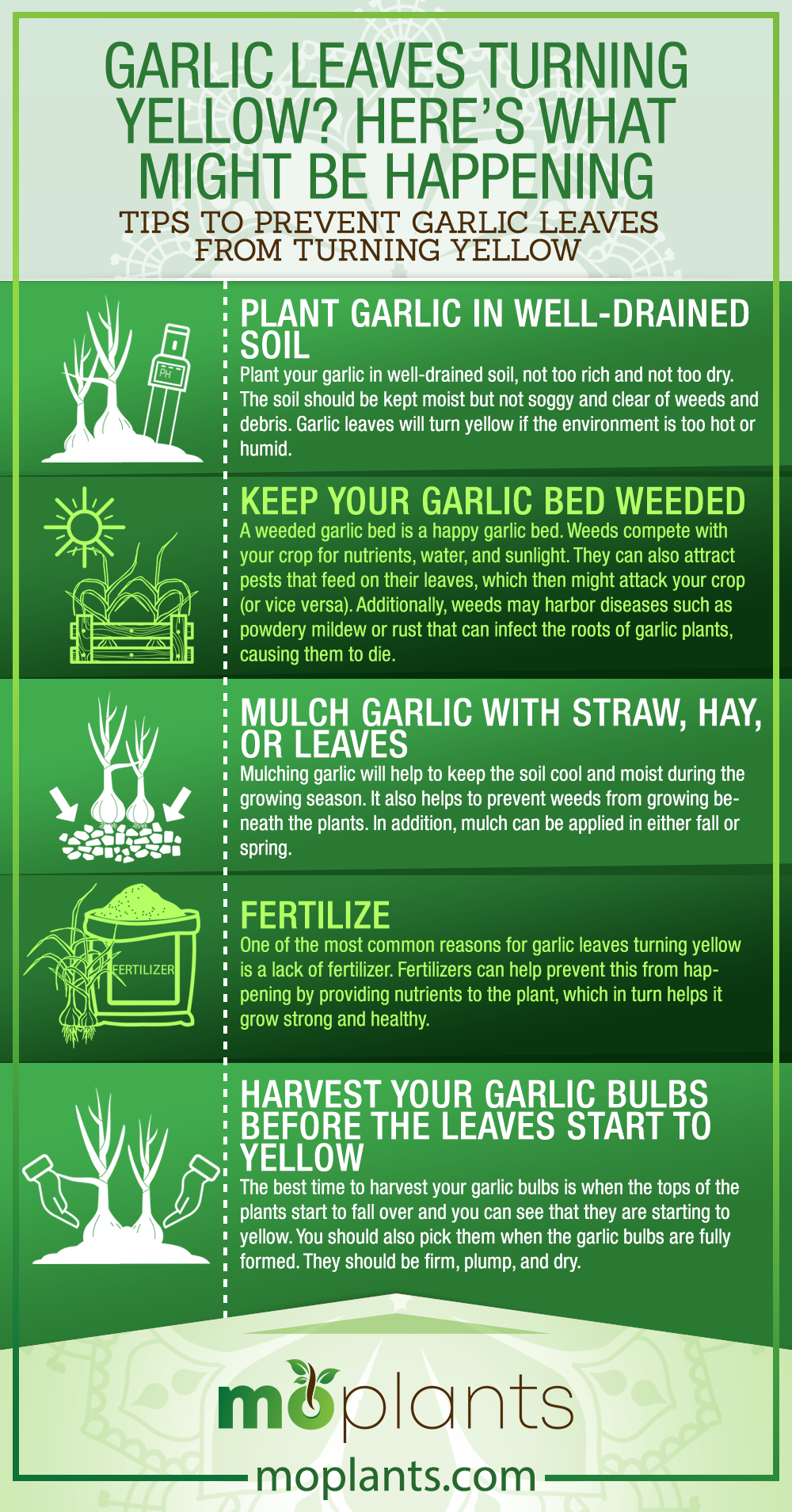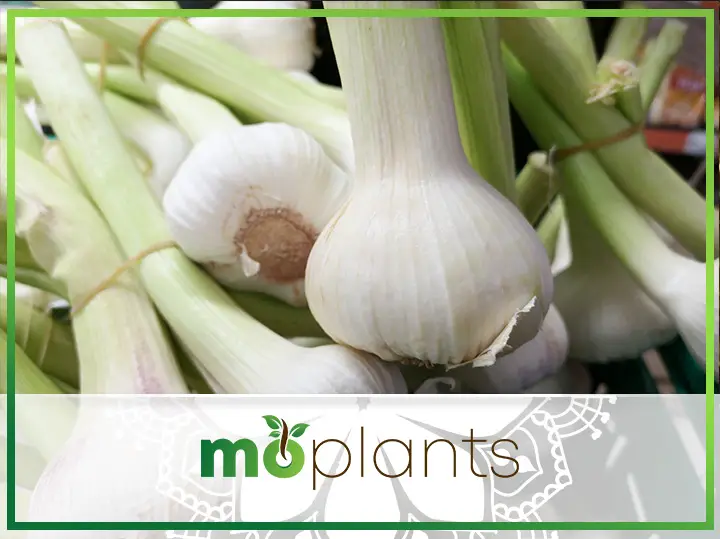If you’ve grown your own garlic, you know that it’s not always the easiest crop to grow. While the garlic bulbs are relatively easy to grow—just plant them in good soil and water them occasionally—the leaves of your garden-grown garlic can be a bit finicky. Sometimes they just go yellow for no reason at all, which can be frustrating if you’re trying to diagnose what’s going on with your plants and find ways to help them recover. So here’s what might cause those leaves of yours to go yellow:
Garlic Leaves May Yellow For A Variety Of Reasons.
If you’ve noticed that your garlic leaves are turning yellow, there could be a variety of reasons.
Garlic leaves may turn yellow due to:
- pests (like slugs and snails) eating the leaves
- too much water or not enough water on the plant
- poor air circulation around the plant, including having it in a pot or container that doesn’t have proper drainage holes
Viruses And Bacteria May Cause Garlic Leaves To Yellow.
The yellowing of garlic leaves can be caused by bacterial and viral diseases. These include Verticillium wilt, blackleg, and leaf spot.
Yellowing is usually more severe on the underside of leaves and may also appear on new growth if a plant has been infected in the spring or fall. If you notice this symptom, examine your plants closely for insects such as aphids feeding on the lower parts of stems or any other signs of pest damage. “Stunted growth” can also indicate that a plant has been severely stressed by an environmental factor such as lack of water; however, it can also mean that there’s something wrong with your plant!
The Soil Is Too Dry
If the soil around your garlic is dry, the plant will often lose its green color and turn yellow instead. To avoid this, make sure to water your garlic regularly, especially during dry spells or drought conditions when rain isn’t always plentiful enough to keep plants hydrated from within their roots upward through their leaves and stems until they reach the surface of the soil where they meet air for photosynthesis (the process by which plants use sunlight energy to make food from carbon dioxide and water).
Garlic Is Exposed To Too Much Sunlight
This can happen when you plant your garlic in a sunny area where it will get direct sun exposure. If you live in an area with hot, sunny summers, try planting your garlic in a shadier spot so it won’t get too much sun.
Yellowing Garlic Leaves Are The First Sign Of Nutrient Deficiency.
Yellowing garlic leaves, while a sure sign of a problem, are not the problem. They’re the classic first symptom of nutrient deficiency. This can be caused by a number of factors, including a lack of sun, excess water, or too much heat.
If your garlic is getting enough sun and water but still has yellowing leaves (or if you’ve planted it in an area where it doesn’t get enough sun), don’t worry: there’s still a chance for survival!
One Of The Most Common Causes Of Garlic Yellowing Is Nitrogen Deficiency.
One of the most common causes of garlic yellowing is nitrogen deficiency. In order to thrive, plants need a balance of nutrients and water. Too much water can lead to root rot, which will cause your plant’s leaves to turn yellow and fall off prematurely.
If you notice that your garlic has been growing in an area with too much rain or not enough sun, this could be causing yellowing. If you’re growing garlic indoors and notice this happening, check whether there are any leaks in the room or if it’s getting too hot from lamps/heaters nearby. Yellowing leaves may also be caused by overfeeding—if you’ve been giving your garlic food particles that contain a lot of nitrogen (green grass clippings, for example) but not enough phosphorus or potassium (animal manure works well), then this imbalance can cause leaf issues like yellowing as well as softening up around their edges instead of turning brown when cut open.
Other Nutrients Garlic Plants Need Include Phosphorus And Sulfur.
If you’re seeing your garlic leaves turning yellow, it could have something to do with the soil. When plants don’t have enough phosphorus in their environment, they can develop a yellowing on the bottom of their leaves. This is because phosphorus is an essential element for normal growth and development in plants. Phosphorus is found throughout all plant tissues, but it’s especially important during photosynthesis—the process by which plants convert light energy into chemical energy that they need to grow and thrive.
Phosphorus makes up much of DNA (deoxyribonucleic acid), which gives instructions for making proteins that carry out certain functions in cells. It also helps regulate cell division so that cells grow only as needed instead of overgrowing and becoming cancerous (which happens when cellular growth goes unchecked). Phosphorus can be found naturally in animal tissues too; however, this nutrient is especially important for plant growth because these organisms cannot produce their own food from scratch like we do!
Another Reason May Be That The Weather Is Too Cold
If your plants are indoors and the temperature is below 60 degrees Fahrenheit, it’s time to move them into a warmer location. If they’re outdoors in an area where the temperature gets lower than 40 degrees Fahrenheit at night, they’ll need to be covered with something like a blanket or plastic sheeting each night until temperatures start rising again.
Additionally, try upping the humidity around your plants by misting them often and keeping them in an area where there’s plenty of moisture in the air (like near a window).
Garlic Leaves Can Also Turn Yellow As They Age.
While garlic leaves can turn yellow for a number of reasons, it’s also true that the yellowing leaf is a natural part of the aging process. Some garlic plants have more-vigorous foliage than others, and their leaves may be in better shape than yours even though they’re older. In general, garlic leaves will tend to turn yellow as they age or as the plant matures; if you’re harvesting your plant at an earlier stage of maturity (when its leaves are still green), this will happen more quickly than if you wait until later on in its life cycle.
The best way to tell whether or not your particular plant has been infected by some kind of pest such as fungus is by looking at other signs besides just leaf coloration—for example, if most or all of your bulbs show signs of infection but only one bulb has yellowed leaves instead, then chances are good that there’s something wrong with that specific bulb rather than anything systemic about all your plants being affected by disease or pests.
Properly diagnosing why your garlic has yellow leaves is the first step toward saving it.
To properly diagnose why your garlic has yellow leaves, examine it with a magnifying glass. If the leaf is simply curling, this is normal. However, if the leaf appears to be splitting or rotting in some way, you may want to contact a professional for further guidance.
Infographic

Tips To Prevent Garlic Leaves From Turning Yellow
Garlic is a staple in many kitchens. The flavor and health benefits of this vegetable add a lot to your meals, but there can be times when you might want to know how to prevent the yellowing of garlic leaves so that your crop doesn’t suffer. Luckily, it’s easy to avoid this problem if you follow these simple tips:
Plant Garlic In Well-Drained Soil
Plant your garlic in well-drained soil, not too rich and not too dry. The soil should be kept moist but not soggy and clear of weeds and debris. Garlic leaves will turn yellow if the environment is too hot or humid.
Keep Your Garlic Bed Weeded
A weeded garlic bed is a happy garlic bed. Weeds compete with your crop for nutrients, water, and sunlight. They can also attract pests that feed on their leaves, which then might attack your crop (or vice versa). Additionally, weeds may harbor diseases such as powdery mildew or rust that can infect the roots of garlic plants, causing them to die. Finally, weeds can damage bulbs by covering them up in soil, so they don’t get enough light to grow properly.
Mulch Garlic With Straw, Hay, Or Leaves
Mulching garlic will help to keep the soil cool and moist during the growing season. It also helps to prevent weeds from growing beneath the plants. In addition, mulch can be applied in either fall or spring. If you choose to apply it while planting your garlic bulbs, use 2 inches of material around each plant; if you decide to apply it later in the growing season, use 1 inch of material around each plant.
Water Regularly During The Growing Season.
Watering should be done in the morning, evening, and afternoon. Watering in the morning will help to keep the soil moist throughout the day. If you water at night, it’s best to do so before bedtime—this will help prevent root rot issues that can occur if you water when temperatures are high outside.
Fertilize
One of the most common reasons for garlic leaves turning yellow is a lack of fertilizer. Fertilizers can help prevent this from happening by providing nutrients to the plant, which in turn helps it grow strong and healthy.
Fertilize your garlic before you plant it in early spring, when the soil temperature has risen above 40 degrees Fahrenheit (4 C). It’s best to use a balanced NPK fertilizer, ideally one with equal parts of nitrogen, phosphorus, and potassium. Additionally, avoid using fertilizers with a high nitrogen content; these will encourage leaf growth at the expense of flower production. Be sure to follow instructions that come with your bag of fertilizer in terms of how much to use per square foot.
Harvest Your Garlic Bulbs Before The Leaves Start To Yellow
The best time to harvest your garlic bulbs is when the tops of the plants start to fall over and you can see that they are starting to yellow. You should also pick them when the garlic bulbs are fully formed. They should be firm, plump, and dry.
When you harvest your garlic, avoid wet soil as this will cause rot in storage after it has been cut from its roots.
Infographic

Yellowing of the garlic leaves can be prevented by proper planting, mulching, and watering.
- Planting the garlic bulbs in well-drained soil. Garlic plants need well-drained soil to grow properly. The best time to plant garlic is between mid-September and late October, as long as you live in a climate where there are no frosts or snowfall until at least November.
- Mulching your garlic plant with organic materials like shredded leaves or grass clippings will help prevent weeds from growing around the roots of the garlic bulb and make it easier for you to weed around them yourself without disturbing the planting area too much when needed.
- Watering regularly after planting is essential; however, do not overwater because this can cause root rot which will lead to yellowing leaves on your plant!
- Fertilizing your garlic plants once per month during their growing season will help promote healthy growth while preventing issues such as yellowing leaves later on down the road—which means more delicious garlic cloves! Just remember that fertilizer can be very harmful if ingested directly by humans so make sure children don’t come into contact with any material containing fertilizers before eating anything made with raw onions/garlic (especially children under 6 years old).
Our Final Thoughts
Hopefully, this article has given you a better idea of what might be causing your garlic leaves to turn yellow. The next step is to find out exactly what’s going on and treat it as needed. If you do find yourself with yellowing leaves, don’t panic—there are plenty of ways to save them! With a little bit of luck on your side and some time spent researching possible causes, you can find the right solution for your unique situation.

